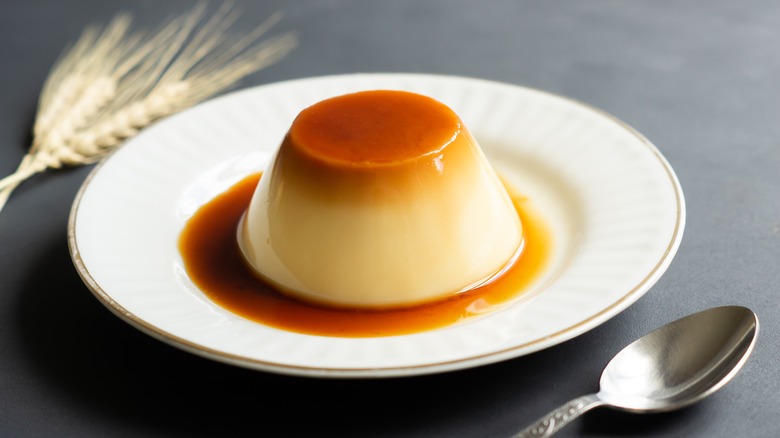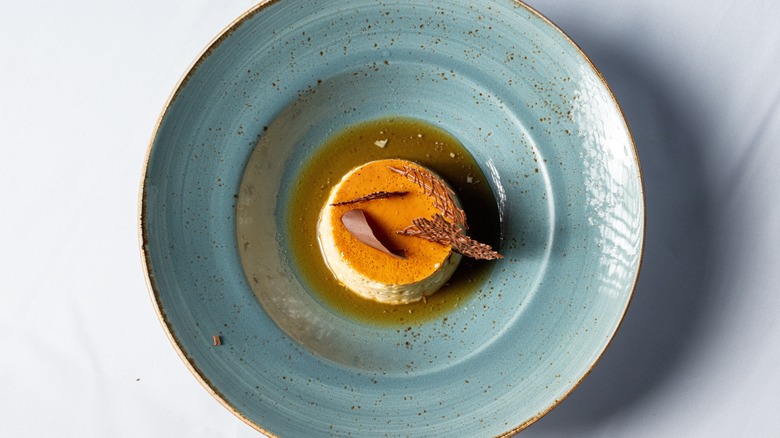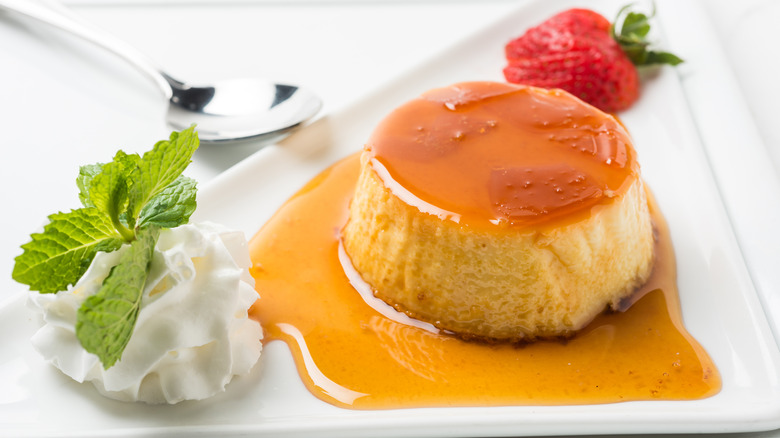How Caramel Became A Main Ingredient For Flan
If you're a dessert aficionado, then you've definitely tried flan, a popular staple of Mexican and Spanish restaurants. However, if you're unfamiliar with the treat, flan is a custard dessert with a caramel top. Made with milk, eggs, sugar, and sometimes vanilla, flan is one creamy dessert. The custard is baked over a caramel bottom, then flipped over when it's served so the caramel drips down from the top along the sides.
For fans of caramel and a creamy texture, flan is just about the perfect dessert. But, as it turns out, caramel wasn't always an ingredient in this custard dessert. This may come as a shock to flan lovers, but the dessert evolved throughout its rich history until the Spanish arrived at the caramel-covered version beloved today.
In fact, the earliest iterations of flan weren't even sweet, if you can believe it. Let's go all the way back to the dessert's origins and track its evolution.
Flan started in Rome as a savory dish
Despite the dessert's strong association with Mexican and Spanish cuisines, flan actually started in Italy — specifically, in Ancient Rome. It all started when the Romans began domesticating chickens to collect their eggs in larger quantities than ever before. From there, they started playing around with various recipes that utilized eggs — leading them to flan, in which eggs are key. But, the Romans were not the ones to come up with the method of mixing eggs and milk in order to make a custard — the Greeks beat them to it.
The earliest version of flan, which was called "flado," was actually a savory custard dish. The Romans used fish or meat to flavor flado, which is a far cry from the caramel sweetness of the flan we know and love today. The savory version eventually made way for the sweet version when the Romans turned to honey to flavor the custard. However, even the sweeter version with honey still had pepper added to it, so it wasn't quite the super-sweet dessert we have nowadays.
The Spanish incorporated caramel into flan
The addition of caramel as an essential part of flan came from Spain. The Spanish were the ones to come up with the idea to add caramelized sugar to the base of flan (which then becomes the top), solidifying it as the iconic dessert that it is today. It's unclear how exactly the Spanish got the idea to add caramelized sugar, but it was around this time that sugar was growing in popularity as an ingredient in general. As the sugar industry grew, people began discovering the various ways that specific foods and beverages could be sweetened with sugar — so, it makes sense that someone would think to sweeten flan. Then, the Spanish colonizers brought flan along when they conquered Mexico's Yucatan Peninsula in 1518. From there, the dessert took off locally, becoming a staple of Mexico and eventually spreading around the world.
As the dessert spread to various countries, each nation put its own unique spin on flan. For example, Mexican flan often includes cream cheese (known as flan napolitano) and makes use of condensed milk rather than regular milk. In fact, just about every Latin country has its own version — Cuban flan often incorporates cinnamon, while the Caribbean islands have a version that is made with coconut milk called flan de coco.


